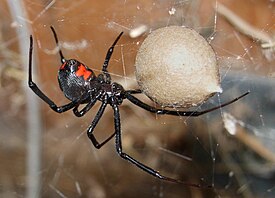Black widow ( lat. Latrodectus mactans ) - a species of spiders , common in North and South America. Danger to humans.
| Black Widow |

female with egg cocoon |
| Scientific classification |
|---|
| No rank : | Bilateral symmetrical |
| Infrastructure : | Araneomorphic Spiders |
|
| International scientific name |
|---|
Latrodectus mactans Fabricius , 1775 |
| Synonyms |
|---|
- Lactrodectus schuchii [1]
|
|
Content
The adult spider is painted black. Females, as a rule, have a red spot in the form of an hourglass on the underside of the abdomen and several red spots near the arachnoid warts and on the back. The body length of the female is 8-10 mm.
Adult black widow males differ from females in small size (3-4 mm in length) and elongated abdomen (in females it is round). Their legs are painted in an orange-black strip, on the sides of the abdomen are red and white marks.
Young spiders are painted white or yellowish-white and darken with each subsequent molt .
Spiders live alone and meet with each other only for mating. The black widow feeds mainly on insects, but sometimes also on centipedes and other spiders. The average life expectancy in nature is about a year, up to a maximum of 3 years, in captivity up to 4.
The female wraps the laid eggs with a cobweb, so that in the end a dense pear-shaped egg cocoon is obtained. The female carries it with her and guards until young spiders hatch inside him. Soon after, they get out of the cocoon and begin an independent life.
Spiders hatch after 2-4 weeks.
The black widow is not aggressive towards a person and bites him only for self-defense in a hopeless situation (if, for example, a spider is pressed by hand). Black widow bites are dangerous - they cause a painful condition known as latrodectism . An hour after the bite, a neurotoxin called α-latrotoxin spreads through the victim's lymphatic system . An extremely painful cramp of the abdominal muscles occurs. Possible vomiting, profuse sweating, thirst. However, with proper treatment, the disease usually ends in complete recovery.
Bite Mortality
Information about the dead from the bites of a black widow is somewhat controversial.
The book “Arthropod venoms” [2] states that, according to a 1932 publication, mortality in the United States was about 6% (38 of 613 cases), with the proviso that these data “certainly do not include cases of mild illness, which would significantly reduce the mortality rate. "
Other authors claim [3] that not a single death is known from spiders of the genus Latrodectus in America (but the literature describes several cases associated with spiders of this genus in other parts of the world).
In our time, about 2,500 black widow bites are registered annually in the United States, only a part of which require medical attention (in 2008 [4] - 2511, of which 996 were required medical assistance; in 2010 [5] - 2156 and 892), none of the patients died.
The spider is called the "black widow", as the female sometimes eats the male after mating. However, it happens that the male leaves safe and sound and may even later mate with another female.
- ↑ Latrodectus mactans (English) on the website of the National Center for Biotechnological Information (NCBI).
- ↑ Arthropod venoms / S. Bettini. - Springer, 1978.- P. 201.
- ↑ Offerman SR, Daubert GP, Clark RF The Treatment of Black Widow Spider Envenomation with Antivenin Latrodectus Mactans: A Case Series // Perm J .. - 2011. - Vol. 15 (3). - P. 76–81. - PMID 22058673 .
- ↑ Bronstein AC, et.al. 2008 Annual Report of the American Association of Poison Control Centers' National Poison Data System. - DOI : 10.3109 / 15563650903438566 .
- ↑ Bronstein AC, et.al. 2010 Annual Report of the American Association of Poison Control Centers' National Poison Data System (NPDS): 28th Annual Report .. - DOI : 10.3109 / 15563650.2011.635149 .
